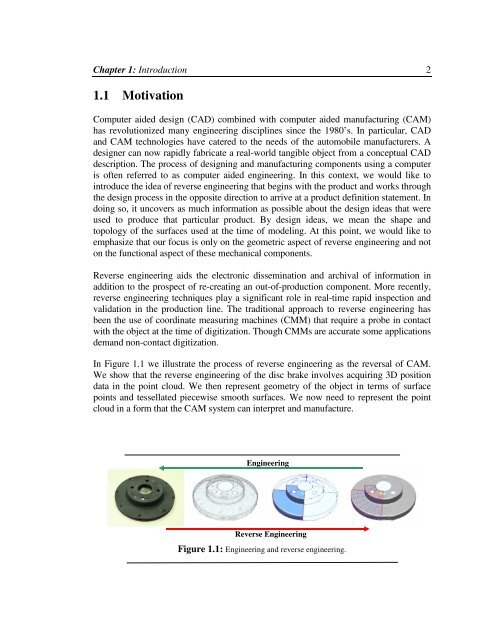To the Graduate Council: I am submitting herewith a thesis written by ...
To the Graduate Council: I am submitting herewith a thesis written by ...
To the Graduate Council: I am submitting herewith a thesis written by ...
You also want an ePaper? Increase the reach of your titles
YUMPU automatically turns print PDFs into web optimized ePapers that Google loves.
Chapter 1: Introduction 21.1 MotivationComputer aided design (CAD) combined with computer aided manufacturing (CAM)has revolutionized many engineering disciplines since <strong>the</strong> 1980’s. In particular, CADand CAM technologies have catered to <strong>the</strong> needs of <strong>the</strong> automobile manufacturers. Adesigner can now rapidly fabricate a real-world tangible object from a conceptual CADdescription. The process of designing and manufacturing components using a computeris often referred to as computer aided engineering. In this context, we would like tointroduce <strong>the</strong> idea of reverse engineering that begins with <strong>the</strong> product and works through<strong>the</strong> design process in <strong>the</strong> opposite direction to arrive at a product definition statement. Indoing so, it uncovers as much information as possible about <strong>the</strong> design ideas that wereused to produce that particular product. By design ideas, we mean <strong>the</strong> shape andtopology of <strong>the</strong> surfaces used at <strong>the</strong> time of modeling. At this point, we would like toemphasize that our focus is only on <strong>the</strong> geometric aspect of reverse engineering and noton <strong>the</strong> functional aspect of <strong>the</strong>se mechanical components.Reverse engineering aids <strong>the</strong> electronic dissemination and archival of information inaddition to <strong>the</strong> prospect of re-creating an out-of-production component. More recently,reverse engineering techniques play a significant role in real-time rapid inspection andvalidation in <strong>the</strong> production line. The traditional approach to reverse engineering hasbeen <strong>the</strong> use of coordinate measuring machines (CMM) that require a probe in contactwith <strong>the</strong> object at <strong>the</strong> time of digitization. Though CMMs are accurate some applicationsdemand non-contact digitization.In Figure 1.1 we illustrate <strong>the</strong> process of reverse engineering as <strong>the</strong> reversal of CAM.We show that <strong>the</strong> reverse engineering of <strong>the</strong> disc brake involves acquiring 3D positiondata in <strong>the</strong> point cloud. We <strong>the</strong>n represent geometry of <strong>the</strong> object in terms of surfacepoints and tessellated piecewise smooth surfaces. We now need to represent <strong>the</strong> pointcloud in a form that <strong>the</strong> CAM system can interpret and manufacture.EngineeringReverse EngineeringFigure 1.1: Engineering and reverse engineering.
















